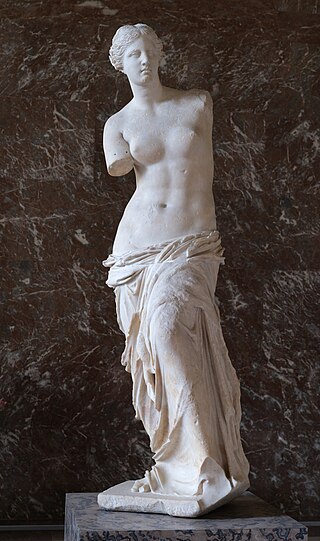
Antonio Canova was an Italian Neoclassical sculptor, famous for his marble sculptures. Often regarded as the greatest of the Neoclassical artists, his sculpture was inspired by the Baroque and the classical revival, and has been characterised as having avoided the melodramatics of the former, and the cold artificiality of the latter.

James Graham Ballard was an English novelist and short-story writer, satirist and essayist known for psychologically provocative works of fiction that explore the relations between human psychology, technology, sex and mass media. Ballard first became associated with New Wave science fiction for post-apocalyptic novels such as The Drowned World (1962). He later courted controversy with the short-story collection The Atrocity Exhibition (1970), which includes the 1968 story "Why I Want to Fuck Ronald Reagan", and later the novel Crash (1973), a story about car-crash fetishists.

The Venus de Milo or Aphrodite of Melos is an ancient Greek marble sculpture that was created during the Hellenistic period. Its exact dating is uncertain, but the modern consensus places it in the 2nd century BC, perhaps between 160 and 110 BC. It was rediscovered in 1820 on the island of Milos, Greece, and has been displayed at the Louvre Museum since 1821. Since the statue's discovery, it has become one of the most famous works of ancient Greek sculpture in the world.

Praxiteles of Athens, the son of Cephisodotus the Elder, was the most renowned of the Attic sculptors of the 4th century BC. He was the first to sculpt the nude female form in a life-size statue. While no indubitably attributable sculpture by Praxiteles is extant, numerous copies of his works have survived; several authors, including Pliny the Elder, wrote of his works; and coins engraved with silhouettes of his various famous statuary types from the period still exist.

Minako Aino, better known as Sailor Venus, is a fictional character in the Sailor Moon and Codename: Sailor V manga series written by Naoko Takeuchi. Minako is her sailor form's alternative human identity as part of the Sailor Guardians, female supernatural fighters who protect the Solar System from evil.

A caryatid is a sculpted female figure serving as an architectural support taking the place of a column or a pillar supporting an entablature on her head. The Greek term karyatides literally means "maidens of Karyai", an ancient town on the Peloponnese. Karyai had a temple dedicated to the goddess Artemis in her aspect of Artemis Karyatis: "As Karyatis she rejoiced in the dances of the nut-tree village of Karyai, those Karyatides, who in their ecstatic round-dance carried on their heads baskets of live reeds, as if they were dancing plants".

One Touch of Venus is a 1943 musical with music written by Kurt Weill, lyrics by Ogden Nash, and book by S. J. Perelman and Nash, based on the 1885 novella The Tinted Venus by Thomas Anstey Guthrie, and very loosely spoofing the Pygmalion myth. The show satirizes contemporary American suburban values, artistic fads and romantic and sexual mores. Weill had been in America for eight years by the time he wrote this musical, and his music, though retaining his early haunting power, had evolved into a very different Broadway style.

Vermilion Sands is a collection of science fiction short stories by British writer J. G. Ballard, first published in 1971. All the stories are set in an imaginary vacation resort called Vermilion Sands which suggests, among other places, Palm Springs in southern California. The characters are generally the wealthy and disaffected, or people who make a living off them, as well as parasites of various kinds.

How to Steal a Million is a 1966 American heist comedy film directed by William Wyler and starring Audrey Hepburn, Peter O'Toole, Eli Wallach, Hugh Griffith, and Charles Boyer. The film is set and was filmed in Paris, though the characters speak entirely in English. Hepburn's clothes were designed by Givenchy.

The Aphrodite of Knidos was an Ancient Greek sculpture of the goddess Aphrodite created by Praxiteles of Athens around the 4th century BC. It was one of the first life-sized representations of the nude female form in Greek history, displaying an alternative idea to male heroic nudity. Praxiteles' Aphrodite was shown nude, reaching for a bath towel while covering her pubis, which, in turn leaves her breasts exposed. Up until this point, Greek sculpture had been dominated by male nude figures. The original Greek sculpture is no longer in existence; however, many Roman copies survive of this influential work of art. Variants of the Venus Pudica are the Venus de' Medici and the Capitoline Venus.

Robert Ingersoll Aitken was an American sculptor. Perhaps his most famous work is the West Pediment of the United States Supreme Court Building.

The Venus de' Medici or Medici Venus is a 1.53 m tall Hellenistic marble sculpture depicting the Greek goddess of love Aphrodite. It is a 1st-century BC marble copy, perhaps made in Athens, of a bronze original Greek sculpture, following the type of the Aphrodite of Knidos, which would have been made by a sculptor in the immediate Praxitelean tradition, perhaps at the end of the century. It has become one of the navigation points by which the progress of the Western classical tradition is traced, the references to it outline the changes of taste and the process of classical scholarship. It is housed in the Uffizi Gallery, Florence, Italy.

A Twist in the Tale is a 1988 collection of short stories by British author and politician Jeffrey Archer. The collection contains 12 stories, which are listed below.

The Crouching Venus is a Hellenistic model of Venus surprised at her bath. Venus crouches with her right knee close to the ground, turns her head to the right and, in most versions, reaches her right arm over to her left shoulder to cover her breasts. To judge by the number of copies that have been excavated on Roman sites in Italy and France, this variant on Venus seems to have been popular.
La Vénus d'Ille is a short story by French writer Prosper Mérimée. It was written in 1835 and published in 1837. It tells the story of a statue of Venus that comes to life and kills the son of its owner, whom it believes to be its husband. This is based on a popular medieval story, of which William of Malmesbury wrote the earliest known version.
"Neck" is a short story by Roald Dahl. It first appeared in his 1953 collection Someone Like You, which consists of 18 short stories.
The Complete Short Stories of J. G. Ballard: Volume 1 is a short story collection by J. G. Ballard, published in 2006.

Zenos Frudakis, known as Frudakis, is an American sculptor whose diverse body of work includes monuments, memorials, portrait busts and statues of living and historic individuals, military subjects, sports figures and animal sculpture. Over the past four decades he has sculpted monumental works and over 100 figurative sculptures included within public and private collections throughout the United States and internationally. Frudakis currently lives and works near Philadelphia, and is best known for his sculpture Freedom, which shows a series of figures breaking free from a wall and is installed in downtown Philadelphia. Other notable works are at Arlington National Cemetery in Virginia, Brookgreen Gardens in South Carolina, the National Academy of Design, and the Lotos Club of New York City, the Imperial War Museum in England, the Utsukushi ga-hara Open Air Museum in Japan, and the U.S. Embassy in Pretoria, South Africa.
Steinunn Þórarinsdóttir is an Icelandic sculptor. Her work uses androgynous human figures such as those in her most notable exhibits Borders and Horizons.














